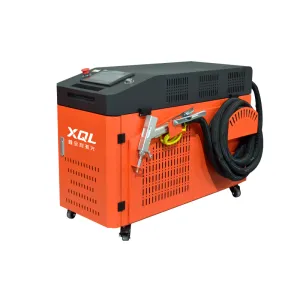Laser cleaning is an environmentally friendly process used to remove rust, paint, oxides and other contaminants from metal surfaces. Due to its efficiency, it is being used in an increasing number of applications. Laser cleaning requires a pulsed fiber laser (typically 50 watts or higher).
It is a cost effective solution that reduces cleaning time and maintenance. If you are skeptical of these claims about laser technology, read on for key facts about the role of lasers in removing contaminants and coatings.

1. Ablation Threshold
Laser ablation occurs when layers of material or coatings are removed with a laser beam. This is the process behind all laser cleaning applications. Take laser removal of rusted steel. When the beam hits the surface, the molecular bonds in the dust or rust layer are broken and ejected from the substrate. In less technical terms, you can imagine that the layer to be removed is simply evaporated by the laser beam.
Now, each material has a specific ablation threshold. In order to successfully remove a layer from a given material, the energy delivered by the laser beam must be higher than the ablation threshold for that particular material.
2. Highly selective
Since each material has an ablation threshold, laser cleaning can distinguish between two or more materials when attempting to remove an unwanted layer from an object. Given a large enough difference in ablation threshold between materials, it is possible to select the material to be removed (i.e., the material with the lower ablation threshold) while leaving the other materials unaffected.
3. Powerful Bursts
Fiber laser cleaning systems can remove any given layer using two different methods. The laser beam is either a continuous light wave or pulsed at a given repetitive frequency. Even if the results are nearly identical, the removal speed will vary from method to method.
For a given surface area, putting the same amount of energy into a short pulse will increase the power. This is like using a larger hammer. A pulsed laser beam is more efficient and provides faster removal than a continuous beam.
4. Environmentally friendly
Since this cleaning method uses only the laser beam to evaporate the layer to be removed, there are virtually no consumables. This is the beauty of the laser, which only requires a power plug to be set up and ready to use.
Most importantly, the laser does not use chemical products or solvents. This makes laser surface cleaning one of the safest solutions when removing rust and coatings. Not only is there no chemical waste to dispose of, but employees are completely safe when working near laser cleaners that meet international laser safety standards.

5. Various applications
Currently, the most common laser cleaning applications include
Welding pretreatment to remove rust and other contaminants from welded areas
Post-weld treatment to remove aluminum and stainless steel oxides
Laser surface treatment to maximize paint adhesion
Laser removal of oxides from specialty alloy ingots
Paint stripping of parts scrapped due to paint defects
In summary
Laser cleaning solutions can overcome many of the problems faced by rust removal and other industrial cleaning applications. By selecting the specific material to be removed, fiber lasers offer a fast and once-and-for-all solution for many industries.
If you are interested in laser cleaning processes, contact a XQL expert. We can guide you through our workstations, production line solutions and OEM laser systems.











